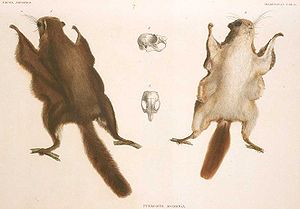Japanese flying squirrel
| Japanese flying squirrel | ||||||||||||
|---|---|---|---|---|---|---|---|---|---|---|---|---|

Japanese flying squirrel ( Pteromys momonga ) |
||||||||||||
| Systematics | ||||||||||||
|
||||||||||||
| Scientific name | ||||||||||||
| Pteromys momonga | ||||||||||||
| Temminck , 1844 |
The Japanese flying squirrel ( Pteromys momonga ) is one of the two species of the real or Old World flying squirrel ( Pteromys ). It occurs on the Japanese islands of Honshu , Shikoku and Kyushu .
features
The Japanese flying squirrel reaches a head-torso length of about 15 to 17 centimeters and a tail length of about 12 to 14 centimeters. The weight is around 150 grams. The back color of the animals is light brown to grayish brown, the belly side and the underside of the sliding skin are white. The head is strong and rounded at the back. Like all dwarf gliding squirrels, it has a hairy skin that connects the wrists and ankles and is enlarged by a fold of skin between the hind legs and the base of the tail. The sliding skin is muscular and reinforced at the edge, it can be tensed and relaxed accordingly in order to control the direction of the gliding flight.
Compared to the Japanese giant flying squirrel ( Petaurista leucogenys ), the Japanese flying squirrel is significantly smaller and only reaches about 15% of the body weight, on the other hand it is about 25% larger than the northern flying squirrel ( Glaucomys sabrinus ), which lives and is known in North America.
distribution
The Japanese flying squirrel is endemic to Japan and occurs on the islands of Honshu , Shikoku and Kyushu .
Way of life
The Japanese flying squirrel lives in the coniferous forests up to the higher altitudes near the tree line of the Japanese islands. It lives on trees and omnivorously feeds on seeds, nuts and fruits as well as buds, leaves and bark. It nests in tree hollows and also in nest boxes provided by humans, and builds its nests from tree bark.
In some parts of its habitat it overlaps with that of the European flying squirrel ( Pteromys volans ), whose range extends to the Japanese islands.
Systematics
The Japanese flying squirrel is classified as an independent species within the genus of the real or Old World flying squirrel ( Pteromys ), which in addition to this species only contains the European flying squirrel ( Pteromys volans ). The first scientific description comes from Coenraad Jacob Temminck from 1844 on the basis of an individual from the island of Kyushu , Japan. No subspecies are distinguished within the species.
Existence, endangerment and protection
The Japanese flying squirrel is relatively common in its range and is listed by the International Union for Conservation of Nature and Natural Resources (IUCN) as not threatened (“least concern”). This status is justified, in addition to the frequency of the species, above all with the non-existent threats in the habitats in Japan.
supporting documents
- ↑ a b c d e f g Richard W. Thorington Jr., John L. Koprowski, Michael A. Steele: Squirrels of the World. Johns Hopkins University Press, Baltimore MD 2012; Pp. 128-129. ISBN 978-1-4214-0469-1
- ↑ a b c Pteromys momonga in the IUCN Red List of Threatened Species 2014.1. Posted by: N. Ishii, Y. Kaneko, 2008. Retrieved June 22, 2014.
- ↑ a b c Don E. Wilson & DeeAnn M. Reeder (eds.): Pteromys momonga in Mammal Species of the World. A Taxonomic and Geographic Reference (3rd ed).
literature
- Richard W. Thorington Jr., John L. Koprowski, Michael A. Steele: Squirrels of the World. Johns Hopkins University Press, Baltimore MD 2012; Pp. 128-129. ISBN 978-1-4214-0469-1
Web links
- Pteromys momonga inthe IUCN Red List of Threatened Species 2014.1. Posted by: N. Ishii, Y. Kaneko, 2008. Retrieved June 22, 2014.